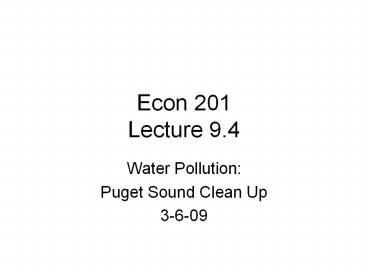Econ 201 Lecture 9.4 - PowerPoint PPT Presentation
1 / 11
Title: Econ 201 Lecture 9.4
1
Econ 201Lecture 9.4
- Water Pollution
- Puget Sound Clean Up
- 3-6-09
2
Efficiency and Cost-Effectiveness
- Ambient Standards and the Zero-Discharge Goal
- The shift from ambient standards to a zero
discharge goal was problematic. - The feasibility of meeting such a goal is small
and thus enforcement is a problem. - On-going law suits
- For some pollutants, such a high cost might be
justified. However, the zero discharge goal does
not distinguish among pollutant types.
3
- National Effluent Standards
- Enforcement Problems
- Cost-effectiveness requires individual standards
for each source, - instead EPA chose general standards for broad
categories of sources - Allocating Control Responsibility
- Studies show that uniform standards do not
closely approximate the least-cost allocation.
4
TABLE 17.2 Empirical Studies of Water Pollution
Control
5
Pretreatment Standards
- Nonpoint Pollution
- Nonpoint source pollution has become a
significant part of the total water quality
problem. - Howerver more intensive controls have been placed
on point sources as an attempt to compensate for
nonpoint sources. - Studies suggest that some nonpoint sources could
be controlled at low costs, especially with
policies aimed at reducing nitrogen use.
6
TABLE 17.3 Summary of NPDES Trading Programs
That Have Traded at Least Once
7
- The European Experience
- In Europe, economic incentives such as effluent
charges play a much larger role. - German experience
- Pay 100 on all pollutants if exceed threshold
- 50 on all if meet minimum standard
- If 75 lower than standard, pay only 50 on
actual - Waived for 3 years if new equipment purchased
which reduces to 20 - Estimated to cost 1/3 of uniform standard
8
Puget Sound Clean Up
- Objectives
- Reduce 150k per day pounds of toxic chemicals
that enter Puget Sound daily - Over 2 years -gt equivalent to Exxon Valdez spill
- Acquire/restore prime marine habitats
- Replace degraded shorelines, wetlands, estuaries
- 40 major species have declined
9
Puget Sound Clean Up Initiative
- Governors proposal
- Added 42M to already allocated 90M
- Puget Sound Partnership
- 10 person team of elected official, business
leaders - Proposed actions
- 21M faster clean-up of pollution and shoreline
- 6.5M upgrade of septic systems -gt into PS
- 4M for Parks to upgrade sewer systems
- 3M restore estuaries (wetlands)
- 2M to remove creosote logs
- 1.5M for oil spill and hazardous chemical
clean-up, including storage
10
Puget Sound Clean Up
- Whats happening today
- Port Gardner Bay Clean Up (9 sites)
- Oil, gasoline, diesel fuels, heavy metals
- Everett shipyard
- North Marina
- Baywoods
- Exxon/Mobil storage
- Weyerhauser
- East Waterway
- ASARCO (Arsenic)
11
An Overall Assessment
- Use of cost-effective policies would reduce costs
substantially while not affecting the benefits. - Economic incentives would also facilitate change
better than technology-based standards that are
rigid. - Marketable permits for water pollution control
are being explored for many bodies of water in
the U.S. - Permits will encourage firms to try to minimize
costs. - Economic incentives put pressure on sources to
find better ways to control pollution.

